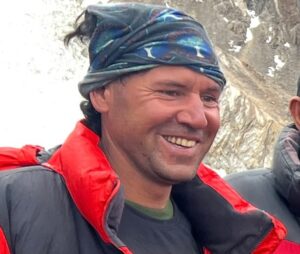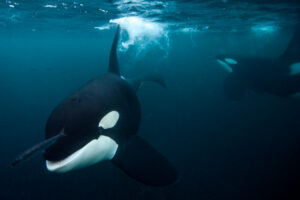Francois Cazzanelli is a pure mountaineer, in the sense that he was born in Aosta in the Italian Alps, to a family of mountain guides. The 32-year-old Cazzanelli has continued the tradition. He has climbed, skied, and hiked virtually all his life. Since he was a teenager, he also trained as an elite athlete on Italy’s ski mountaineering team, competing — and often winning — European and World championships.
So Cazzanelli was already quite experienced when he first set foot in Nepal at the age of 22. His goal was not an 8,000’er, but 7,371m Churen Himal, a secondary point on the Dhaulagiri massif.
Two years later, he headed for Kangchenjunga with Emrik Favre, Marco Camandona, Marco Confortola, and Franco Nicolini. Neither peak was easy for the young Cazzenelli.
Early lessons from thin air
“I struggled with lack of acclimatization on both expeditions,” he told Explorersweb. “I was always behind the others.” He reached the top of Churen Himal but had to retreat on Kangchenjunga.

Francois Cazzanelli at age 22 on Kangchenjunga. Photo: Francois Cazanelli
“I think my body was not ready for that kind of physical effort,” he said.
In 2016, he attempted the spectacular Chamlang, near Makalu.
“In this case, I totally changed my acclimatization approach, from traditional parameters like those used by my mentor Marco Camandona, to those similar to Kilian Jornet’s. These focused not so much on accumulating hours at altitude but on quality training.
“I am an athlete, my body needs to move all the time, and the moment I understood this, my performance at altitude improved a great deal,” he said. “By the time I speed-climbed Manaslu in 2019, I only needed 13 days after arriving in Base Camp. I acclimatized fast.”
Cazzanelli also believes the body has an acclimatization memory. The more one goes to the Himalaya, the less time it takes to acclimatize.
An athlete’s training
In addition to his place on Italy’s skimo team, Cazanneli trains by climbing on rock, ice, and mixed terrain. “For me, it is important to change your activity on a monthly or, weekly basis,” he says. “I have problems focusing on just one thing for too long.”

Francois Cazzanelli with Jerome Perruquet and Pietro Picco on the summit of K2. Photo: Instagram
Light and fast on Manaslu
Manaslu was his first speed ascent in the Himalaya. It was the perfect place for such an attempt.
“During the season, ropes were fixed and resources were at hand. I had a team. Also, my Manaslu expedition had a double goal. Before the speed climb, we aimed for a new route on Pangpoche. In the end, we didn’t summit because of difficult conditions, but it was a great expedition on a mountain we didn’t know, on technical terrain, and with two amazing bivouacs.”

Dressed for speed on Manaslu.
Cazzanelli climbs without Sherpa support or supplementary O2. “I always carry my own gear,” he said. He only used bottled gas once, on Everest, where he guided a client in 2018.
“On Manaslu, I was able to acclimatize on the mountain itself so I got to know the route very well,” he said. “I knew, for instance, where to change to high-altitude boots. It was totally different on Broad Peak this summer, where I had no personal experience with the route, only what I had read online. In a way, it was like onsighting the peak.”
Tips for speedsters
“I always make sure I drink plenty of liquid,” he explained, “usually water with some kind of salt below 7,000m. From that point to the summit — only Coca-Cola!”
Indeed, the climber admits that he always carries a couple of bottles of Coke on his summit pushes, because for him, the beverage works better than anything else above 7,000 or 7,500m. To eat, he mixes energy gels or bars, and normal food like chocolate or biscuits.

Cazzanelli, at right in the red jacket, progresses on Manaslu’s summit ridge.
Cazzanelli managed to avoid the crowds on normal 8,000m routes by going at a different time from most of the climbers. “I never had to wait in the fixed ropes,” he said.
On those normal routes, he doesn’t expect things always to be as perfect as they were on Nanga Parbat this past summer. “There was only me and my friends on summit day. There were no fixed ropes above Camp 3, but no crowds, either. No more than seven people were on the entire mountain.”
On June 26, the Italians literally ran up the mountain in order to summit before an expected storm. It took them two days. Peruvian Cesar Rosales joined them.
Cazzanelli regards Nanga Parbat as the perfect expedition. One week after summiting, he and Pietro Picco opened a new variation route (between Base Camp and Camp 2) on the normal Kinshoffer route.

The variation route opened by the Italian team on Nanga Parbat in the summer of 2022.
Lots of possibilities near normal routes
“The new variation is meaningful for Pietro (Picco) and me because we really wanted to do something different,” Cazzanelli said. “The huge faces of the 8,000’ers, such as the Diamir Face, are full of possibilities, often very near the normal route.
“The line we climbed was only doable in the conditions we encountered on the mountain, after a heavy snowstorm. Otherwise, it would have been dry and highly dangerous. We were in the right place at the right time.”
What was a perfect expedition for Cazzanelli was less so for many other teams. Most couldn’t summit Nanga Parbat because of unrelenting bad weather.
Afterward, the Italians moved to Broad Peak and K2. Cazzanelli summited Broad Peak fast and light, and this time he was not the only one. On his way, he crossed paths with Benjamin Vedrines, who made it to the top in an astonishing seven hours. Denis Urubko was also there, climbing fast. Ten days later, he summited K2 with Pietro Picco and Jerome Perruquet. “A dream come true,” he said.
Alpinists and tourists
Although Cazzanelli was not affected by the crowds this season, as a mountain guide on the Matterhorn, he is used to lots of people. “We guides have been working in the Alps for over 250 years, equipping routes, building huts…and our main business is tourism, so it’s good to see other nations getting the most out of it.
“The problem now in the Himalaya, and the challenge for the future is to make a clear difference between alpinism and mountain tourism,” Cazzanelli said. “We can’t use the same terminology for both activities. Although they’re on a different scale, some of those climbs are not so different from people climbing the Matterhorn.”

Cazzanelli guiding in the Alps. The Matterhorn rises in the background.
What exactly is the difference, in his view? “If you hire a Sherpa, it’s the same thing as hiring a guide in the Alps. That is tourism. The same with using supplementary O2.”
No such thing as mountain speed records
Cazzanneli was not so sure how to assess climbs done without O2 or Sherpas but using the fixed ropes.
“On some mountains such as K2, ropes are necessary, and still the climb is not easy,” he said. “Still, this approach can’t be considered pure alpinism either, especially when outfitters fix too many ropes, not only on difficult sections but also on easy, flat terrain.”
What about the sporting approach to high-altitude climbing, such as speed records? What’s his take on FKTs (as we recently discussed with Kilian Jornet) and these so-called speed records?

Cazzanelli opens a new route on the Breithorn, in the Swiss Alps. Photo: Facebook
“I have never spoken of records,” Cazzanelli said.”Not in interviews, on social media, or anywhere else. You can achieve a faster or slower time for a climb, and registering it is a good way to compare with other alpinists, but the word ‘record’ makes no sense because conditions are different every time, especially in the Himalaya.”
Cazzanelli refers to his speed climbs as simply fast and light.
“I climb fast and light not to make the fastest time,” he explains. “I use speed as a tool to increase safety by spending less time at extreme altitude.
He always tries to start his chronometer at a fixed point. “On Manaslu, for instance, I started from the memorial to fallen climbers, because it’s a fixed point, a landmark. To say you “started from Base Camp” doesn’t make much sense in a place like Manaslu, where the Base Camp is huge.”
Dreams and plans
Cazzanelli is not interested in climbing the 14×8,000’ers. He prefers flexible objectives and doesn’t enjoy waiting out bad weather for weeks. “It is good to have several options in mind, and to change goals if conditions are not right,” he says.






